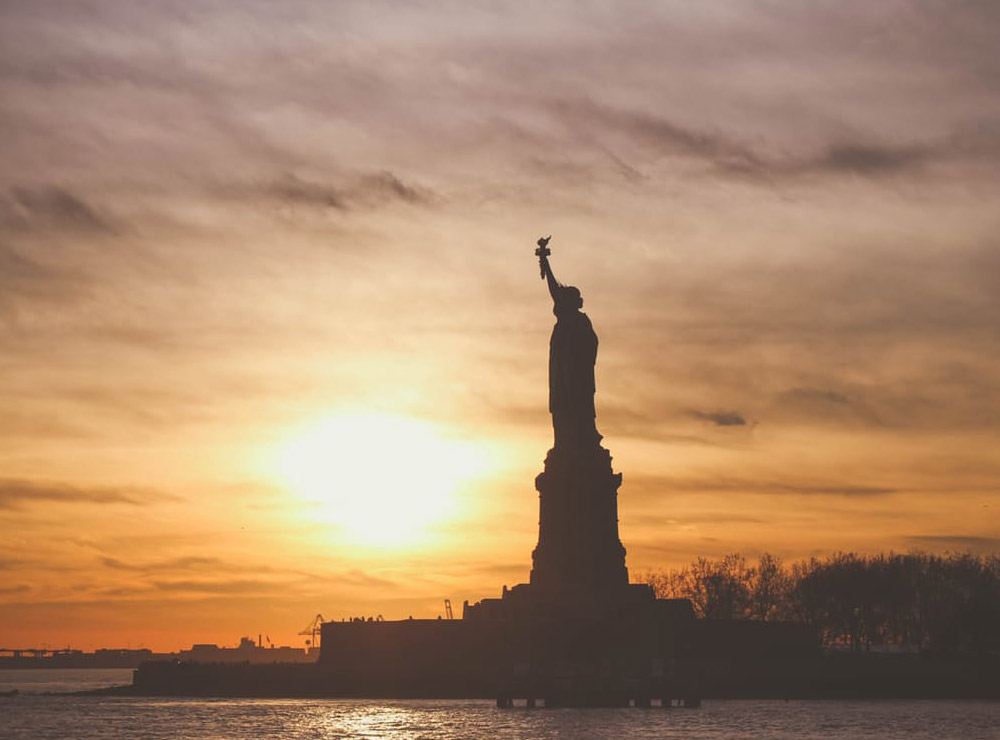This piece by Carys Davies is part of the International Literature Showcase's 'Crossing Borders' series.
I’m in New York this year, working on a novel about the settlement of the American west, and like everything else here since the morning of November 9th when Donald J. Trump was elected the 45th President of the United States, it’s impossible to think about it without considering what, if anything, his election has to do with it all.
Since the summer, I’ve been holed up in the crepuscular chill of the Manuscripts and Archives Division of the New York Public Library, reading diaries and newspaper reports, speeches and letters, treaties and maps and land transfer documents, and all the other pieces of paper that catalogue this period of American history, when, in the late eighteenth and early to mid-nineteenth century, the frontier of the United States moved further and further west. It’s a story of hope and ambition; of greed and duplicity; of good and bad intentions; of land-grab and illegal settlement; of the mass expulsion and migration of peoples; of the power of the strong over the weak, of the rich over the poor.
The archive is extraordinary, the amount of material vast, but in amongst the boxes of loose papers and notebooks (some so fragile there is nothing you can do to stop the edges of the papers crumbling as you turn them), I’ve stumbled across two handwritten diaries which between them manage to tell a large part of what happened.
'It was a long and arduous journey and these were tense, dangerous times.'
The first is by William Hartshorne, a 51 year-old Quaker turnpike-builder and hardware merchant, who in the spring of 1793, set off with a small group of fellow Quakers on a 2,000 mile round trip from New York to Detroit to try and broker a peace agreement between the newly-minted government of the United States and the Native American tribes of the north.
It was a long and arduous journey and these were tense, dangerous times, as European settlers continue to push north and west into Native American territory.
It was roastingly hot – 102 degrees in the shade. They travelled slowly by water, up along the interconnected rivers and lakes, by ferry, barge, schooner and sloop, staying in taverns, garrisons, private houses and rain-flooded tents. The city of Detroit was a fortress: ‘a compact, dirty little town containing about 100 small houses, entirely surrounded by a wall and having several gates which are always shut.’
As Hartshorne and his six-strong party of Quakers travelled north, word was that the Native American tribes in the region were refusing to budge in their demand that settlement on their lands go no further. A contemporary newspaper report, also in the archive here, talks of ‘the Indians [being] increasingly restive under the westward pressure of white settlers’.
‘Nothing,’ wrote Hartshorne, ‘short of the boundary line being fixed at the River Ohio will ever induce them to lay down the hatchet.’
It didn’t help that reports were coming in that Major General ‘Mad’ Anthony Wayne was on his way north to subdue the native tribes once and for all, ‘increasing the jealousy and rage of the Indians’ and heightening the tension. Even Hartshorne’s courageous party was worried that ‘it will not be safe for us to meet the Indians at Sandusky, Ohio,’ where the talks were to take place.
Nevertheless, they pressed on.
En route they provided corn and flour to ‘140 Indians [who] were much distressed for want of provisions, occasioned by their being frequently removed from place to place since their first forcible removal from [the] Muskingum [River]. They have,’ he notes, ‘a very poor chance of hunting in their new settlement.’
New, European settlements, he observed along the way, were ‘very rapidly increasing in size and beauty.’
By early summer, around Sandusky, in an atmosphere of high tension, the ten tribes due to attend the talks – including the Iroquois, Shawnees, Wyandots and Delawares – were beginning to assemble. Hartshorne and his party introduced themselves: ‘We are the Quakers…we have left our homes and our families in New York and Pennsylvania….we consider all Men as the Children of our common Father and our duty is to love all our Brothers.’
Put simply, Hartshorne wanted to bring about an agreement between the ten tribes and the government of the United States that was peaceful and fair.
He had good cause to believe that, without his group’s being there to observe, it wouldn’t be. In his diary he writes of William Blount, the notoriously aggressive land speculator and sole Governor of the Southwest Territory (later Tennessee) ‘who by bribing an interpreter had cheated [the region’s tribes] out of a great extent of their country and defrauded them of one half of the sum agreed upon to be paid yearly as a compensation for the land granted.’
Hartshorne and his five companions (William Savery, Joseph Moore, John Parrish, John Elliott and Jacob Lindley) were here to try and make sure the same thing didn’t happen again.
As it was, the talks did not go well and the two sides never got as far as negotiating a deal.
Hartshorne and his five fellow Quakers listened quietly while Indian spokesmen addressed the US Commissioners. Through a translator their chiefs made clear their position: ‘the bitter water [of the oceans] was made for the white folks, but the water of the Brooks and Rivers for the Indians…they are now determined to be driven no further. The Congress must remove their fort and all their People and then the Indian will take them by the hand and become their true friend.’
No, said Timothy Pickering, President George Washington’s Postmaster General and head of the US Commissioners.
Pickering told the chiefs of ‘the impossibility of removing such a great number of families from their habitations and farms.’ He was willing, he said, to compensate them for some of their land but would not agree to the Ohio River being the boundary line.
The talks collapsed and Hartshorne and his party began their 1,000 mile journey home.
A year later, in August 1794, in the Miami River valley in Ohio, Major General ‘Mad’ Anthony Wayne, commanding the Western Army, crushed a 2,000 strong force of Native American tribesmen, the largest ever to assemble for a single battle. General Wayne then burned the surrounding Indian villages and in 1795 dictated the terms of the Treaty of Greenville to ‘the disappointed savages’, and opened Ohio for settlement, condemning the tribes to live on reservations.
***
The second diary I’ve come across takes up the story sixty years later, in 1852, when the trickle of white settlers into the west has become a flood, pushing the indigenous tribes before it, further and further from their ancestral lands.
The author this time is Lodisa Frizzel, about whom nothing, the library archivist tells me, is known, other than what she recorded in this small, neatly handwritten notebook that’s dotted with her bright, naïvely-drawn illustrations.
Lodisa set off in the spring, headed for California, along with her husband Lloyd, ‘5 yoke of cattle and one pony,’ and a wagon loaded with 800 lbs of supplies in barrels, sacs and a trunk, containing, amongst other stores, ‘plenty of bread, meat, crackers, fruit and pickles.’
By the time the couple reached St. Louis, on the Mississippi, there were queues; traffic jams: ‘This morning we went down to the ferry and crossed over and with much difficulty forced our way through the narrow streets which were crowded with drays….[There were] ‘not half enough ferryboats – pushing, crowding, everything from a handcart to a wheelbarrow to a fine 6 horse carriage, teams and wagon and buggies but more than two thirds are oxen and wagons similar to ours and by the looks of their loads they do not intend to starve.’
Further on, in the town of St. Joseph, Missouri, ‘all around the town was white with wagons and tents.’ Looking down on the town from the top of a hill, Lodisa had never seen ‘so much bustle.’
Mostly, as the Frizzel wagon trundles west, Lodisa is preoccupied with the difficulties of their journey: with having ‘very little water’; with there being almost no firewood to cook with; with the ‘100 or so graves’ they pass on the road between St Joseph and the Blue River; with the reports of cholera and measles outbreaks up ahead; with procuring a cow; and with how it is ‘impossible to keep anything clean.’
Very occasionally, though, she writes about the Native Americans she and her husband Lloyd encounter on their journey.
In St. Louis, where she comes across them for the first time, she writes about them as a kind of strange and intriguing spectacle: ‘It is a novel sight to see them, their faces painted and tattooed, wrapped in their red blankets with a kind of cap on their heads and stuck in the top were from one to a dozen long feathers of various colours, and by a word to their ponies, for I seldom see them use a whip, they scamper away with the speed of the wind.’
Later on, she finds them annoying and rather greedy because they charge the settlers – the so-called ‘Californians’ – tolls to cross certain rivers as they make their way west.
'In all stories from the past there are implications for the present.'
There’s a moment, though, when she almost unwittingly records the disaster that has unfolded in just five decades since William Hartshorne journeyed to Sandusky. Observing ‘an old Indian who wraps himself in a blanket and walks into a thicket,’ she remarks that he looks ‘noble’ and reflects on his ‘reduced situation since the white man came. Perhaps he was the elder of a tribe where once there were so many.’
I won’t be writing about either William or Lodisa because writing fiction is, above all, about making things up.
But I’m glad to have found them, because history is an echo chamber, and in all stories from the past there are implications for the present. And in reading and re-reading these diaries, and the other papers in the archive here, what strikes me most forcibly is how in this history, as in all history, there are voices which have been captured and recorded for posterity, like William Hartshorne’s and Lodisa Frizzel’s, and there are voices which went almost unheard, certainly unlistened to, like that of the ‘old Indian’ seen walking off in to a thicket.
Which is where we come back to Donald Trump, and his nativist ‘America for Americans’ message. He won the presidency partly by persuading the white indigenous natives of today’s United States that he understands their sense of loss, their sense of dispossession; that he is listening to them when no one else is; that he understands their fears that their world is threatened by alien technology and robotics, by alien moral values like same sex marriage and transgender bathrooms, and alien people, like Mexicans.
There are all kinds of vast differences, of course, between the Native Americans of the eighteenth and nineteenth centuries, and the people who voted for Donald Trump to be their President in 2016. But it seems to me that the biggest difference is that one group had no voice, or vote, and the other did. The migration story has gone through another cycle, except the descendants of yesterday’s winners now feel like today’s losers, and they have made that very, very clear. What happens next, like everything else, will be history.
Carys Davies
Award-winning, widely anthologised short story writer, north-west England
SEE PROFILE






